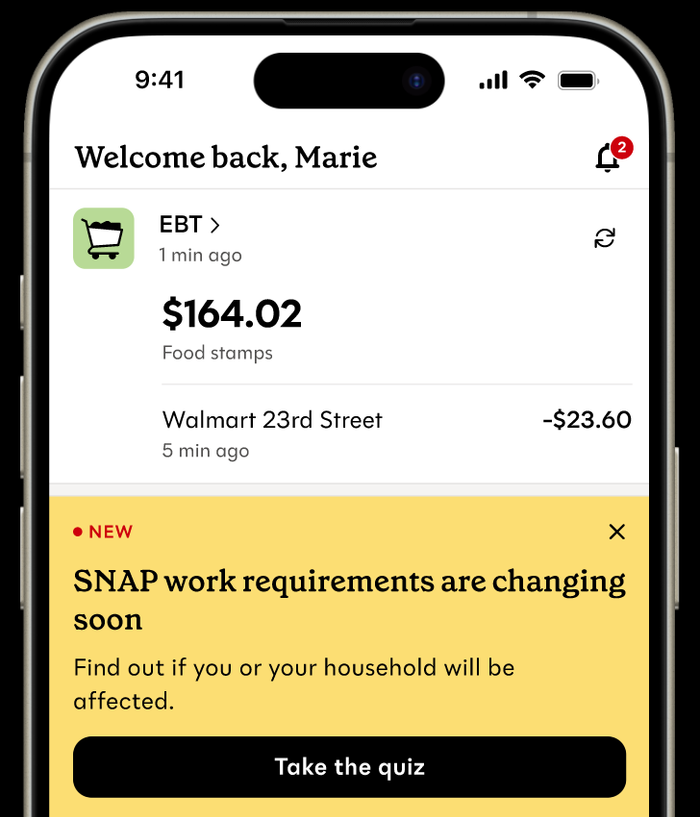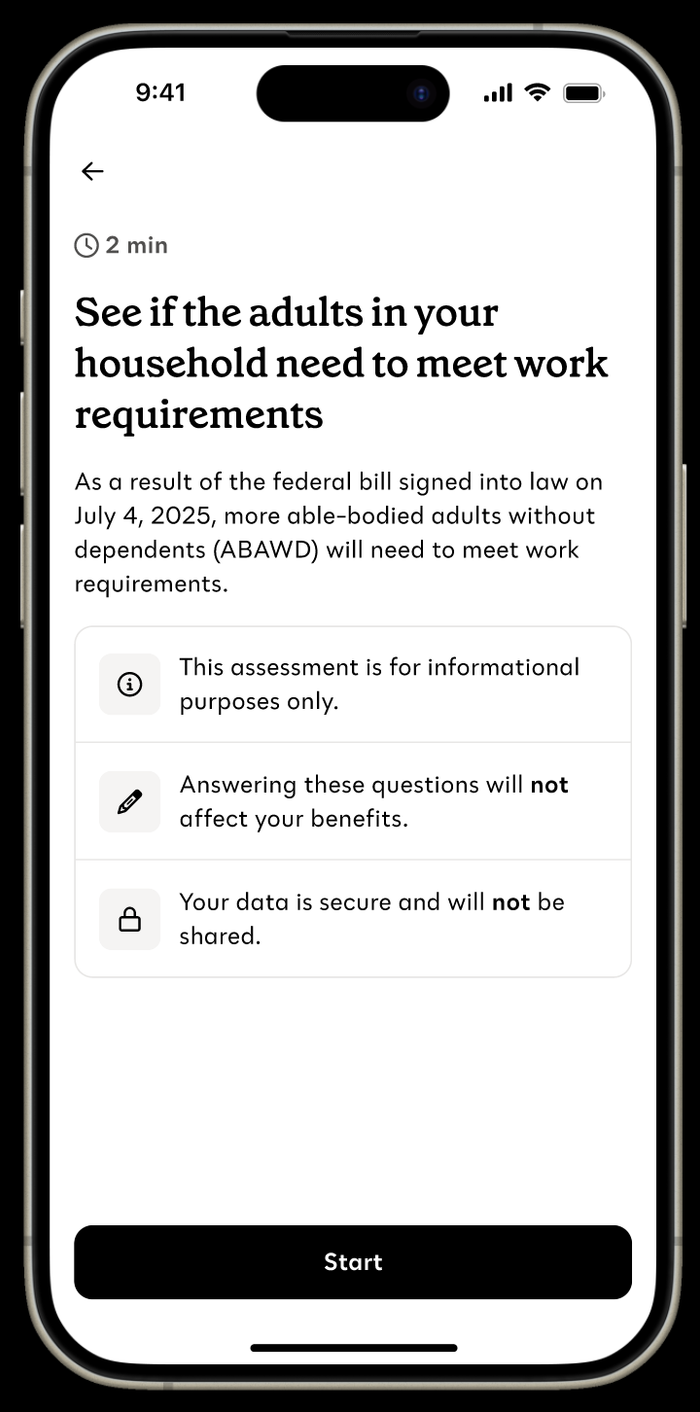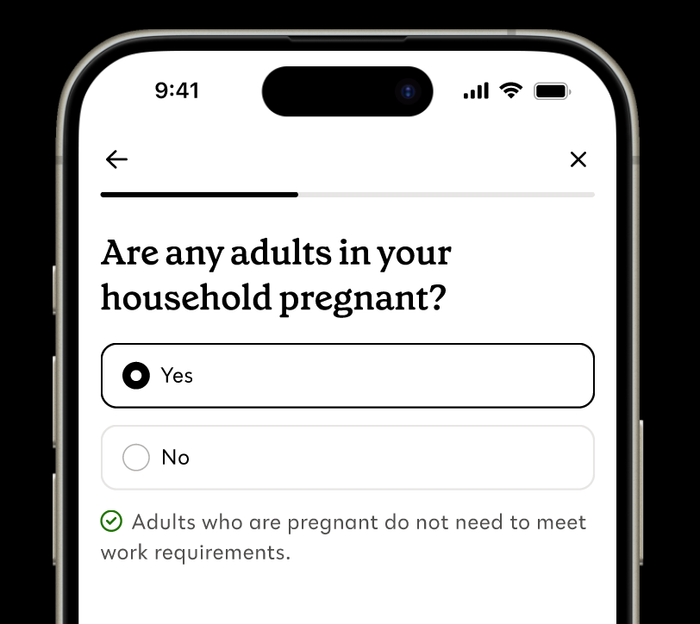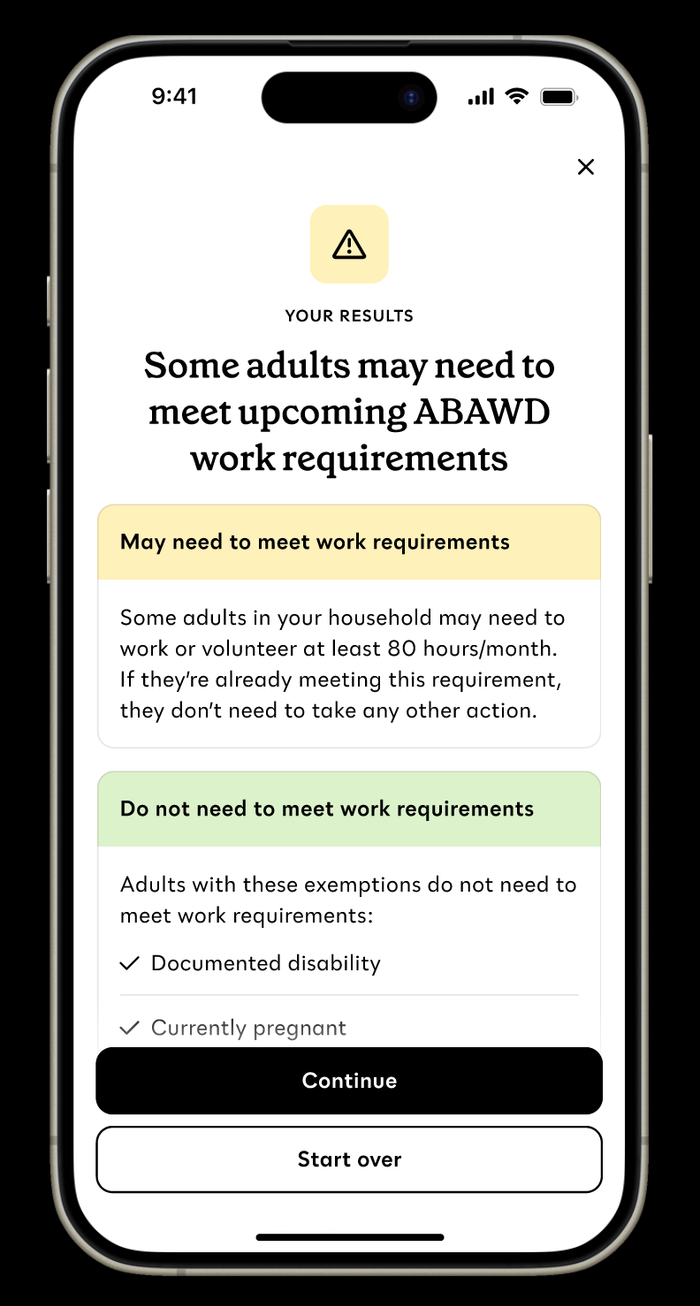Helping a million SNAP recipients navigate work requirement changes
When Congress passed the One Big Beautiful Bill Act on July 3, 2025, it marked one of the most significant legislative changes to SNAP in the program's history. The new law expanded SNAP work requirements to many more Americans, including adults aged 55-64, parents of teenagers, veterans, and people experiencing homelessness.
These changes created uncertainty for millions of SNAP recipients who wanted to understand how the rule changes would affect their benefits specifically.
The Propel app is used every month by 5.5 million people — roughly one in every four SNAP households nationwide. We saw this uncertainty firsthand among our users, and quickly took action to help them get clarity.
Delivering initial help at scale#delivering-initial-help-at-scale
In late July, we launched a work requirements screener to help SNAP recipients understand if members of their household might need to take action to keep their SNAP benefits. To date, more than 1 million people have used this screener.


The work requirements screener walks through a household's details, and identifies if some or all members of the household may be subject to work requirements after the passage of the law.
In the context of a question where a "Yes" means the household member is exempt, it proactively states this.

And at the end, it tells the user if some, all, or none of the household's members are likely to be subject to work requirements.

The design challenge: balancing simplicity with accuracy#the-design-challenge-balancing-simplicity-with-accuracy
Creating this tool involved wrestling with complex policy that varies by individual circumstances. Our product team made several strategic design decisions to maximize both accessibility for the maximum number of people using it and substantive accuracy:
We chose low barriers to entry over perfect precision#we-chose-low-barriers-to-entry-over-perfect-precision
We deliberately avoided requiring extensive documentation up front that would be needed for a highly precise answer: there was no uploading documents or creating detailed profiles for every household member.
Instead, we asked general questions at the household level, trusting users to apply the information to their specific situations.
This trade-off meant using more cautious language in our final assessment, but it also dramatically increased the number of people able to successfully complete the screener and get helpful information, while reducing the amount of time it would take them to do so.
We streamlined for most users while including information on less common situations#we-streamlined-for-most-users-while-including-information-on-less-common-situations
We focused on the most common scenarios while ensuring less common exemptions, such as for members of federally recognized tribes or California Indians eligible for Indian Health Services, were addressed through additional FAQs and detailed information. This kept the tool manageable while remaining comprehensive and accurate.
We balanced more frequently used terminology with technical correctness#we-balanced-more-frequently-used-terminology-with-technical-correctness
For example, the screener used the "ABAWD" (able-bodied adults without dependents) acronym because most users and official agency websites were using this term to describe the 3-month time limit work requirements at the time — despite the fact that the new law actually made some adults with dependents subject to those time limits.
What we learned#what-we-learned
The data we collected revealed the need for navigation guidance like ours.
More than 40% of users of the screener are in a household where some or all members are subject to work requirements.
- For 42% of users of the screener, someone in their household will likely need to meet work requirements
- For 23%, it was some adults in the household
- For 19%, it was all adults in the household
- 58% of users learned no one in their household would likely be required to meet work requirements.
- This is because, for example, there are young children in the household, everyone is 65 or older, or household members are living with disabilities.
In a post-usage survey, 85% of screener users rated the tool as helpful.
Among the 15% who rated the results as "not helpful," the majority were seeking more specific guidance for nuanced situations. Their feedback consistently asked questions like "I'm currently [specific situation]... do I need to comply?"
This demonstrates both the complexity of the policy and users' deep need for personalized, definitive answers about their specific circumstances — particularly around disability-related exemptions. Often someone may have a disability that makes work difficult, but not be receiving disability benefits that automatically exempt them. 28% of users of the screener overall had someone with a disability in their household.
The implementation challenge ahead#the-implementation-challenge-ahead
While our screener helped create initial clarity for a large number of our users about their SNAP benefits, the more significant challenges are coming up. On October 3, 2025, USDA released guidance to states on implementing the OBBB work requirement changes, including guidance affecting previous state waivers.
Key implementation challenges include:
- Many existing policy waivers will expire sooner than initially anticipated
- States must update their systems to track changes in exemption categories
- Clear communication will be needed to ensure people who need to submit exemptions or proof of qualifying work successfully do so
- State agencies will likely face higher workload, needing to process more exemptions and work documentation in addition to existing case work
What’s next#whats-next
In just a few months since the OBBB's passage, we have helped more than 1 million SNAP recipients understand how these major legislative changes to SNAP are likely to affect their specific situation.
We learned that 58% of those who completed our screener are likely exempt from work requirements, and hopefully assuaged some anxiety for them. And for the other 42%, they now know they will likely need to take action in the coming months to keep their benefits. Most importantly for our objective of providing meaningful help to our users, 85% found tool helpful for their situation.
We are carefully tracking information from state SNAP agencies as they implement these changes to provide accurate and timely guidance to our users.
As states work through implementation, clear, accessible communication will be important to preventing unnecessary benefit loss. The complexity we've seen in user feedback — particularly around disability exemptions and questions about very specific household situations — shows that states will likely need multiple touchpoints and channels to ensure everyone is successfully reached. Not everyone will receive or understand notices the agency sends, and additional outreach with simplified language can enable more people to take needed actions, and hopefully also reduce unnecessary phone calls asking for clarification.
We at Propel want to support agencies in implementing these changes successfully, and preventing unnecessary benefit loss among eligible families.
If you are with a state agency, and would like to amplify your program messaging or do targeted outreach to clients via the Propel app, please reach out at gov@propel.app. We want to ensure people have the information needed to take action and avoid losing benefits, and want to work in coordination with state agencies to make these changes as seamless for eligible households as possible.

